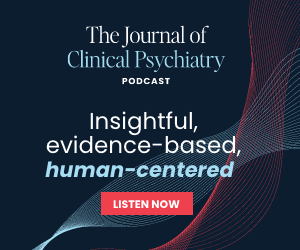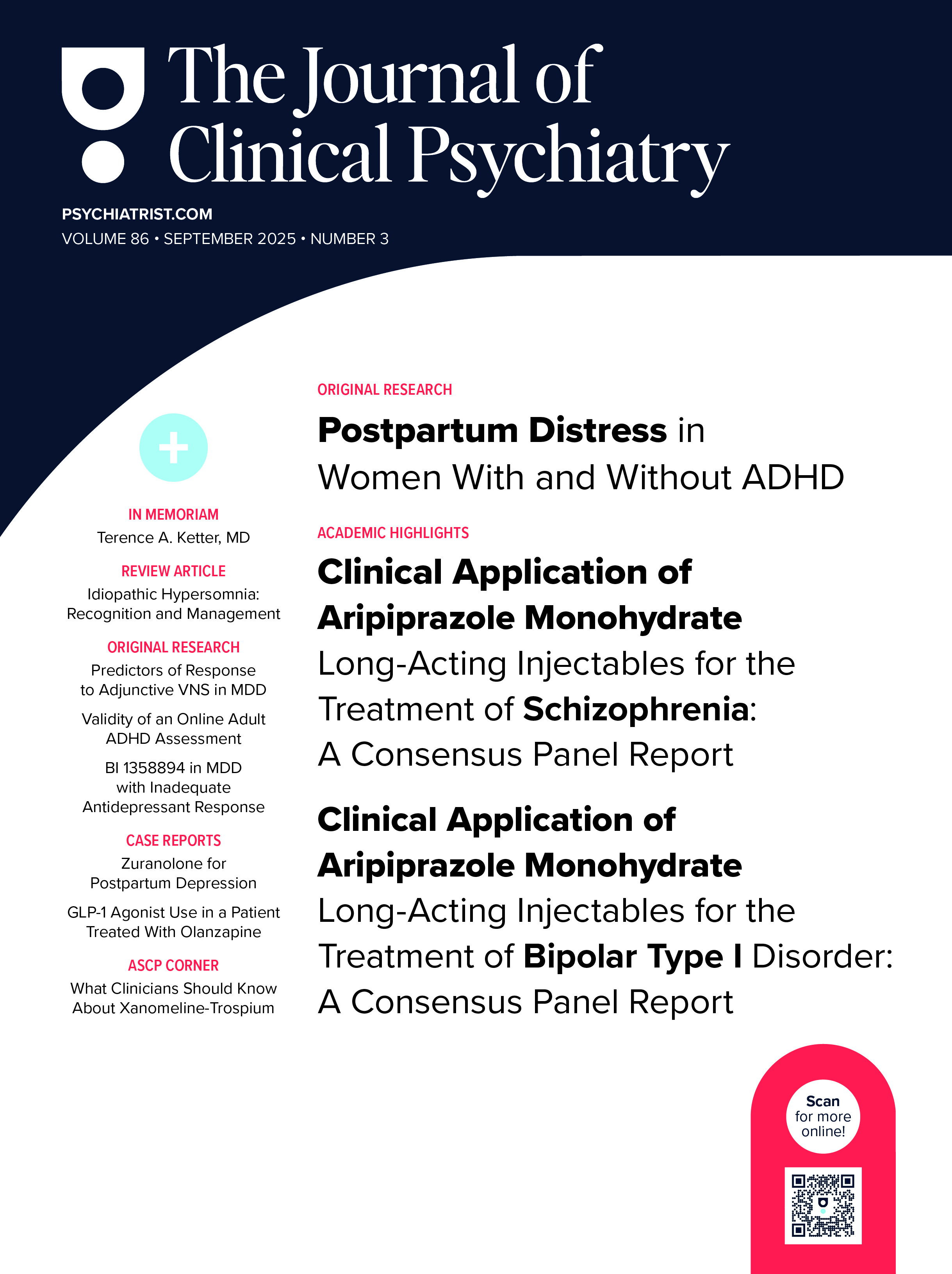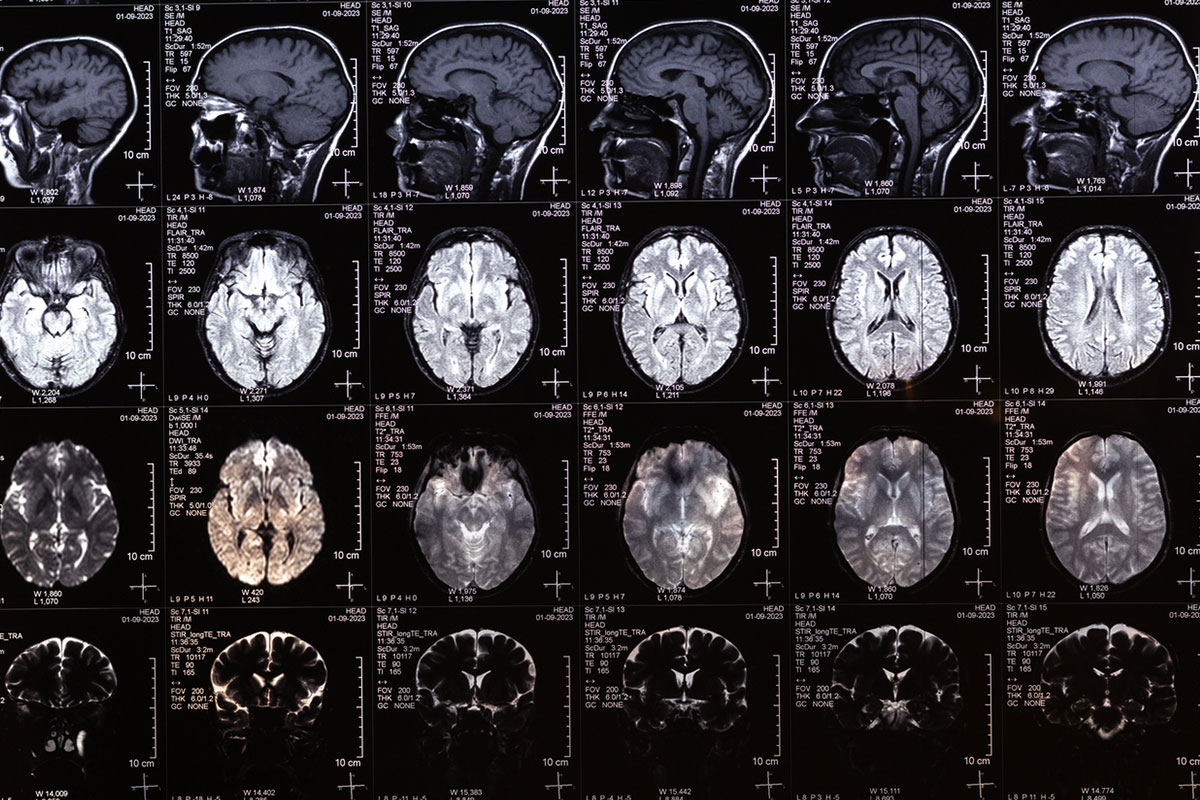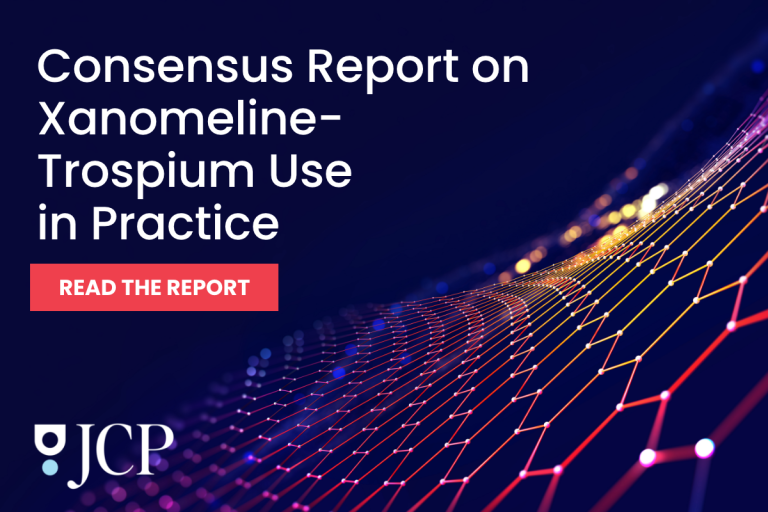
Abstract
Background: Antidepressant tolerance/ tachyphylaxis (AT) is defined as initial response (≥ 50% improvement) to antidepressant treatment followed by relapse while on the same adequate dose. The impact of AT as prognostic indicator for response to subsequent antidepressant treatment is unknown.
Objective: To test the efficacy of esmethadone (REL-1017) in a subgroup of patients with major depressive disorder (MDD) and AT.
Methods: A phase 3, double-blind, randomized, placebo-controlled trial of esmethadone was conducted in adult outpatients with MDD. Prior to randomization, AT was independently assessed by clinicians from the Massachusetts General Hospital Clinical Trials Network and Institute using the MGH Antidepressant Treatment Response Questionnaire. Data for the primary efficacy end point were analyzed using mean difference in Montgomery-Åsberg Depression Rating Scale (MADRS) total score from baseline to primary end point (Day 28) in the AT subgroup from the intent to treat (ITT) population, the per-protocol (PP) population, and in patients with severe depression (baseline MADRS ≥35).
Results: Among 227 ITT patients, 87 experienced AT. For this subgroup, there was a nominally statistically significant mean difference of 5.4 (P=.023, Cohen effect size 0.53) for esmethadone vs placebo in MADRS total score change from baseline to primary end point (Day 28). Additionally, there was a nominally statistically significant difference in response rate (P=.0004). Consistent results were seen in the PP population with AT and in the severely depressed subgroup of patients with AT.
Conclusions: These post hoc analyses, based on data collected independently pre-randomization, suggest that esmethadone may be an effective adjunctive treatment for patients with AT. These results need to be confirmed in larger prospective clinical trials.
J Clin Psychiatry 2025;86(4):24m15748
Author affiliations are listed at the end of this article.
Members Only Content
This full article is available exclusively to Professional tier members. Subscribe now to unlock the HTML version and gain unlimited access to our entire library plus all PDFs. If you’re already a subscriber, please log in below to continue reading.
References (37)

- Solomon DA, Keller MB, Leon AC, et al. Multiple recurrences of major depressive disorder. Am J Psychiatry. 2000;157(2):229–233. PubMed CrossRef
- Fava M, Davidson KG. Definition and epidemiology of treatment-resistant depression. Psychiatr Clin North Am. 1996;19(2):179–200. PubMed CrossRef
- Kinrys G, Gold AK, Pisano VD, et al. Tachyphylaxis in major depressive disorder: a review of the current state of research. J Affect Disord. 2019;245:488–497. PubMed CrossRef
- Targum SD. Identification and treatment of antidepressant tachyphylaxis. Innov ClinNeurosci. 2014;11(3–4):24–28. PubMed
- Desseilles M, Witte J, Chang TE, et al. Assessing the adequacy of past antidepressant trials: a clinician’s guide to the antidepressant treatment response questionnaire. J Clin Psychiatry. 2011;72(8):1152–1154. PubMed CrossRef
- Fava GA, Offidani E. The mechanisms of tolerance in antidepressant action. Prog Neuropsychopharmacol Biol Psychiatry. 2011;35(7):1593–1602. PubMed CrossRef
- Amsterdam JD, Williams D, Michelson D, et al. Tachyphylaxis after repeated antidepressant drug exposure in patients with recurrent major depressive disorder. Neuropsychobiology. 2009;59(4):227–233. PubMed CrossRef
- Posternak MA, Zimmerman M. Dual reuptake inhibitors incur lower rates of tachyphylaxis than selective serotonin reuptake inhibitors: a retrospective study. J Clin Psychiatry. 2005;66(6):705–707. PubMed CrossRef
- Thase ME, Friedman ES, Howland RH. Venlafaxine and treatment-resistant depression. Depress Anxiety. 2000;12(suppl 1):55–62. PubMed CrossRef
- Thase ME, Entsuah AR, Rudolph RL. Remission rates during treatment with venlafaxine or selective serotonin reuptake inhibitors. Br J Psychiatry. 2001;178:234–241. PubMed CrossRef
- Katz G. Tachyphylaxis/Tolerance to antidepressants in treatment of dysthymia: results of a retrospective naturalistic chart review study. Psychiatry Clin Neurosci. 2011;65(5):499–504. PubMed CrossRef
- Fornaro M, Anastasia A, Novello S, et al. The emergence of loss of efficacy during antidepressant drug treatment for major depressive disorder: an integrative review of evidence, mechanisms, and clinical implications. Pharmacol Res. 2019;139:494–502. PubMed CrossRef
- Pollock BG, Ferrell RE, Mulsant BH, et al. Allelic variation in the serotonin transporter promoter affects onset of paroxetine treatment response in late-life depression. Neuropsychopharmacology. 2000;23(5):587–590. PubMed CrossRef
- Neumeister A, Hu XZ, Luckenbaugh DA, et al. Differential effects of 5-HTTLPR genotypes on the behavioral and neural responses to tryptophan depletion in patients with major depression and controls. Arch Gen Psychiatry. 2006;63(9):978–986. PubMed CrossRef
- Musliner KL, Agerbo E, Vilhjálmsson BJ, et al. Polygenic liability and recurrence of depression in patients with first-onset depression treated in hospital-based settings. JAMA Psychiatry. 2021;78(7):792–795. PubMed CrossRef
- Schmidt ME, Fava M, Zhang S, et al. Treatment approaches to major depressive disorder relapse. Part 1: dose increase. Psychother Psychosom. 2002;71(4):190–194. PubMed CrossRef
- Fava M, Detke MJ, Balestrieri M, et al. Management of depression relapse: re-initiation of duloxetine treatment or dose increase. J Psychiatr Res. 2006;40(4):328–336. PubMed CrossRef
- Bernstein G, Davis K, Mills C, et al. Characterization of the safety and pharmacokinetic profile of D-methadone, a novel N-methyl-D-aspartate receptor antagonist in healthy, opioid-naive subjects: results of two phase 1 studies. J Clin Psychopharmacol. 2019;39(3):226–237. PubMed CrossRef
- Ferri N, De Martin S, Stuart J, et al. Drug-drug interaction studies of esmethadone (REL-1017) involving CYP3A4- and CYP2D6-mediated metabolism. Drugs R D. 2024;24(1):51–68. PubMed CrossRef
- Ferri N, De Martin S, Stuart J, et al. Pharmacokinetics, tolerability, and safety of esmethadone in subjects with chronic kidney disease or hepatic impairment. Drugs R D. 2024;24(2):341–352. PubMed CrossRef
- Fava M, Stahl S, Pani L, et al. REL-1017 (esmethadone) as adjunctive treatment in patients with major depressive disorder: a phase 2a randomized double-blind trial. Am J Psychiatry. 2022;179(2):122–131. PubMed CrossRef
- Fava M, Stahl SM, Pani L, et al. Efficacy and safety of esmethadone (REL-1017) in patients with major depressive disorder and inadequate response to standard antidepressants: a phase 3 randomized controlled trial. J Clin Psychiatry. 2024;85(3):24m15265. PubMed CrossRef
- Fava M, Stahl SM, De Martin S, et al. Esmethadone-HCl (REL-1017): a promising rapid antidepressant. Eur Arch Psychiatry Clin Neurosci. 2023;273(7):1463–1476. PubMed CrossRef
- Shram MJ, Henningfield JE, Apseloff G, et al. The novel uncompetitive NMDA receptor antagonist esmethadone (REL-1017) has no meaningful abuse potential in recreational drug users. Transl Psychiatry. 2023;13(1):192. PubMed CrossRef
- Fava M, Pani L, De Martin S, et al. Long-Term safety and efficacy of esmethadone in patients with major depressive disorder: findings from a 12-month open-label study. J Clin Psychiatry. 2025;86(1):24m15438. PubMed CrossRef
- Tu TH, Huang KL, Bai YM, et al. Exposure to second-generation antipsychotics and risk of type 2 diabetes mellitus in adolescents and young adults: a nationwide study in Taiwan. J Clin Psychiatry. 2019;80(2):18m12284. PubMed CrossRef
- Misdrahi D, Tessier A, Daubigney A, et al. Prevalence of and risk factors for extrapyramidal side effects of antipsychotics: results from the national FACE-SZ Cohort. J Clin Psychiatry. 2019;80(1):18m12246. PubMed CrossRef
- Godin O, Leboyer M, Schürhoff F, et al. Metabolic syndrome and illness severity predict relapse at 1-year follow-up in schizophrenia: the FACE-SZ Cohort. J Clin Psychiatry. 2018;79(6):17m12007. PubMed CrossRef
- Chandler GM, Iosifescu DV, Pollack MH, et al. RESEARCH: validation of the Massachusetts General Hospital Antidepressant Treatment History Questionnaire (ATRQ). CNS Neurosci Ther. 2010;16(5):322–325. PubMed CrossRef
- Desseilles M, Witte J, Chang TE, et al. Massachusetts General Hospital SAFER criteria for clinical trials and research. Harv Rev Psychiatry. 2013;21(5):269–274. PubMed CrossRef
- Stahl SM, De Martin S, Mattarei A, et al. Esmethadone (REL-1017) and other uncompetitive NMDAR channel blockers May improve mood disorders via modulation of synaptic kinase-mediated signaling. Int J Mol Sci. 2022;23(20):12196. PubMed CrossRef
- Trujillo KA, Akil H. Inhibition of morphine tolerance and dependence by the NMDA receptor antagonist MK-801. Science. 1991;251(4989):85–87. PubMed CrossRef
- Fogaça MV, Fukumoto K, Franklin T, et al. N-Methyl-D-aspartate receptor antagonist d-methadone produces rapid, mTORC1-dependent antidepressant effects. Neuropsychopharmacology. 2019;44(13):2230–2238. PubMed
- Casarotto PC, Girych M, Fred SM, et al. Antidepressant drugs act by directly binding to TrkB neurotrophin receptors. Cell. 2021;184(5):1299–1313.e19. PubMed CrossRef
- De Martin S, Gabbia D, Folli F, et al. REL-1017 (esmethadone) increases circulating BDNF levels in healthy subjects of a phase 1 clinical study. Front Pharmacol. 2021;12:671859. PubMed CrossRef
- Freeman MP, Pooley J, Flynn MJ, et al. Guarding the gate: remote structured assessments to enhance enrollment precision in depression trials. J Clin Psychopharmacol. 2017;37(2):176–181. PubMed CrossRef
- Shiovitz TM, Zarrow ME, Shiovitz AM, et al. Failure rate and “professional subjects” in clinical trials of major depressive disorder. J Clin Psychiatry. 2011;72(9):1284–1285. PubMed CrossRef





